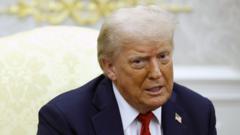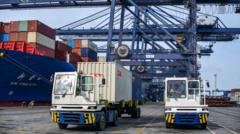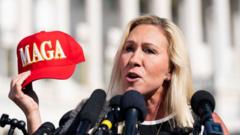The recent rulings on President Trump's tariffs have sparked confusion and instability that could affect the global economy and American consumers.
**Uncertainty in Trade Policy: Court Rulings on Tariffs Send Shockwaves**

**Uncertainty in Trade Policy: Court Rulings on Tariffs Send Shockwaves**
A convoluted legal battle shakes the foundations of U.S. trade strategy, raising questions about the future of tariffs and trade negotiations.
In a dramatic turn of events, a series of contentious court rulings concerning President Trump's tariff policies have left Washington and global markets reeling. These rulings not only question the validity of the substantial tariffs imposed on foreign nations but also highlight potential shifts in U.S. trade strategy that could reshape international relations and economic frameworks.
Just a day after the U.S. Court of International Trade invalidated some of Trump's broad tariffs, another court stepped in to temporarily reinstate them, unveiling a complex legal landscape rife with unpredictability. As the Trump administration battles to defend its policies, the ramifications on the global economy, U.S. consumers, and businesses loom large. Many are left wondering whether import tariffs will be lowered or if Trump will continue to exert his significant influence over the global trading system.
Central to this ongoing legal dispute is Trump's invocation of a longstanding economic emergency statute to impose sweeping tariffs, including a minimum 10 percent levy on nearly all U.S. trading partners. Just recently, a panel of judges affirmatively stated that Trump misapplied this law, arguing that Congress did not endow him with "unbounded authority" to initiate a trade conflict at will. As a result of the initial ruling, the administration faced a deadline to reverse several of its levies. However, the government swiftly appealed to a federal court, seeking to maintain the controversial tariffs while a more comprehensive evaluation of Trump's arguments unfolds.
The appellate court's decision to pause the earlier ruling offers temporary respite for the Trump tariffs and allows legal scrutiny to delve deeper into this critical issue—a matter that might eventually reach the Supreme Court for a definitive resolution on the limits of presidential powers in trade matters. As this saga continues, the pressure mounts on the administration to clarify its stance and strategy, leaving consumers and global partners on alert for the economic implications that lie ahead.
Just a day after the U.S. Court of International Trade invalidated some of Trump's broad tariffs, another court stepped in to temporarily reinstate them, unveiling a complex legal landscape rife with unpredictability. As the Trump administration battles to defend its policies, the ramifications on the global economy, U.S. consumers, and businesses loom large. Many are left wondering whether import tariffs will be lowered or if Trump will continue to exert his significant influence over the global trading system.
Central to this ongoing legal dispute is Trump's invocation of a longstanding economic emergency statute to impose sweeping tariffs, including a minimum 10 percent levy on nearly all U.S. trading partners. Just recently, a panel of judges affirmatively stated that Trump misapplied this law, arguing that Congress did not endow him with "unbounded authority" to initiate a trade conflict at will. As a result of the initial ruling, the administration faced a deadline to reverse several of its levies. However, the government swiftly appealed to a federal court, seeking to maintain the controversial tariffs while a more comprehensive evaluation of Trump's arguments unfolds.
The appellate court's decision to pause the earlier ruling offers temporary respite for the Trump tariffs and allows legal scrutiny to delve deeper into this critical issue—a matter that might eventually reach the Supreme Court for a definitive resolution on the limits of presidential powers in trade matters. As this saga continues, the pressure mounts on the administration to clarify its stance and strategy, leaving consumers and global partners on alert for the economic implications that lie ahead.




















